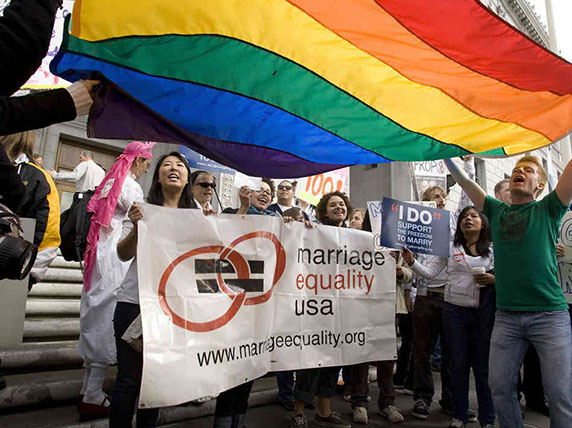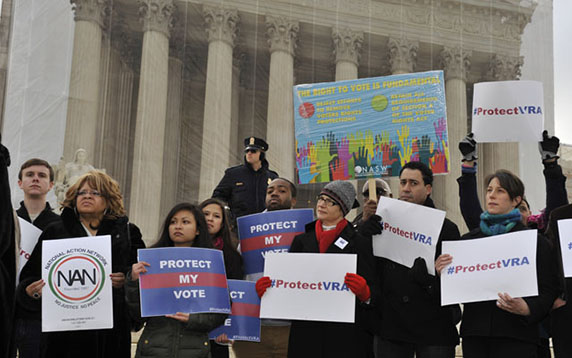by Barry Sheppard
July 8, 2013
Two rulings by the Supreme Court: one a big step forward and the other a leap backward. Both by a 5 to 4 vote.
First the good news. The Court struck down the federal Defense of Marriage Act (DOMA) that defined marriage as a right of only heterosexal couples. DOMA was passed by Congress and signed into law by Democratic President Clinton in 1996.

A crowd celebrates the decision to strike down DOMA.
It also declined to rule against a lower court that found unconstitutional the California law, passed by referendum in 2008, which outlawed same-sex marriage. This opened the door for same-sex marriages to resume in the state.
There has been an immediate and massive flocking by same-sex couples to city halls throughout California to exercise their rights, in joyous ceremonies and celebrations.
Gay Pride demonstrations in California and other states on June 30 turned into huge celebrations.
DOMA had been used to bar couples in same-sex marriages, in states that had legalized them, from receiving federal benefits that heterosexual married couples enjoyed. These were many and often material, such as spousal social security and tax benefits.
It was this discrepancy that the Court ruled unconstitutional. The Court did not rule that laws in states which bar same-sex marriages are unconstitutional, however, so this was not a sweeping legal victory.
Nevertheless, the tide has turned. Now it is the anti-gay bigots that are on the defensive.
As it stands now, there are 13 states (now including California) and Washington, D.C. where same-sex marriages are legal. The fight now shifts to the remaining states. There will be all kinds of legal complications resulting from the different laws in different states.
While these struggles will continue, the Court’s decision has wider impact. All aspects of the discrimination against and oppression of LGTBI people can now be attacked.
This victory was made possible not by five wise men and women. In fact, they are wise only in serving the best interests of the ruling class. They do react to political changes that mean they have to give up their previous positions.
What made this decision possible was the gay liberation movement, which widened over time to include other people oppressed because of their sexuality.
We can mark the beginning with the resistance put up by gay men and lesbians at the Stonewall bar in 1969 to what had been a regular practice of the New York police of gay bashing at places where “deviates” socialized.
That was the beginning of a new movement, one that did have precedents in earlier struggles. But this new movement grew out of the youth radicalization of “The Sixties” and the new wave of feminism.
That’s when the gay pride demonstrations began.
Another manifestation was the rise of Act Up with the AIDS epidemic, which first appeared among gay men. This was not only an important fight to demand government action against the disease, but mobilized gays into militant mass action.
By their own mass actions, gays, lesbians and others became publicly visible. The idea that you could fight back, and not just be relegated to the closet and second-class citizenship began to take hold. Now the “fairies” and “dykes” were not just objects of ridicule, but in-your-face fighters.
As the movement developed, more and more people “came out.” The cumulative effect was that more and more straight people began to realize that many of their sons and daughters, their brothers and sisters, their friends and coworkers were LGBTI.
Attitudes began to change. Even arch-reactionaries and creeps like Dick Cheney, who has a lesbian daughter, were affected.
Partial victories for equal rights did not result in the dire predictions of the church and other bigots.
Now a majority of Americans support same-sex marriage, and a greater majority support equal rights in general. That’s what won this victory.
* * * * *

A crowd demonstrates in support of the Voting Rights Act.
In the second ruling, the Court struck down one of most important legal victories of “The Sixties,” the 1965 Voting Rights Act. That victory was made possible by the massive mobilizations of African-Americans and their supporters in the civil rights movement in the Jim Crow South and the mass Black liberation movement in the country as a whole.
All major Black and civil liberties organizations denounced the ruling. Even President Obama managed to say he was “disappointed.”
The immediate struggle that preceded the Voting Rights Act was the 1965 marches for Black voting rights in Alabama. The first march began in Selma, and was intended to go to the state capital, Montgomery.
Alabama Governor George Wallace, a notorious racist, called out the state troopers, who were augmented by white thugs organized by the local sheriff, armed with whips. These forces stopped the nonviolent march in a bloody attack that left many injured.
John Lewis, the head of the Student Nonviolent Coordinating Committee (SNCC), suffered a fractured skull.
The attack was televised, and Americans were stunned by the violence. A second march was planned, which President Johnson sought to ban. But when the organizers wouldn’t back down, Johnson relented and sent federal troops to protect the marchers.
Under mass pressure throughout the country, Congress responded by passing the Voting Rights Act, which Johnson signed.
The historical background goes back to the Civil War, when the Slavocracy was defeated and the former slaves granted citizenship and the (male) right to vote.
The “compromise” of 1877 between the Federal government and white Southern capitalists and landowners was the turning point in taking away African-Americans’ right to vote and the establishment of the whole system of racial oppression known as Jim Crow, through mass anti-Black terror throughout the former Confederacy.
The fight for the right to vote was one of main demands of the new civil rights movement that emerged in the mid-1950s. Many bloody struggles culminated in Selma and the Voting Rights Act.
This short sketch explains why the key section of the Act was Federal overseeing of voting rights in the Jim Crow states. Voting rights for Blacks there could only be established by outside force. It was this key provision that the Supreme Court threw out.
The majority of the Court claimed that the South had reformed, and there now was no need of federal oversight of these states’ voting procedures. This is of a piece with claims that the U.S. is now a “color-blind” society.
The great Black struggle of “The Sixties” has indeed wrought major changes in the United States. But institutional racism still pervades society, as can be seen by every social measurement from unemployment, poverty, education, health, persistent housing segregation, levels of imprisonment, etc.
Moreover, the white South has always resented the federal oversight of voting rights and other victories of the civil rights movement. This is one source of the right-wing’s objection to “Big Government.” There have been persistent attempts to attack Black voting rights, not only in the South but in other states, too.
This was dramatically seen in the 2012 elections, when there were all kinds of attempts through laws and outright restrictions on the availability of polling places and machines in Black neighborhoods, forcing African-Americans to wait in long lines, sometimes for 10-12 hours, to vote.
(There were attempts to limit voting rights of Latinos, too, in some states, which I won’t take up in this article.)
Within 48 hours of the Court’s striking down the Voting Rights Act, six states immediately took moves to restrict voting rights.
In Texas, a strict voter identification law and redistricting plan designed to limit Black voting rights were blocked last year by the Department of Justice last year. Now, they will go into effect.
Similar voter ID schemes in Mississippi, Alabama, Arkansas, South Carolina and Virginia will proceed.
Obama says it is now up to Congress to fix the situation – within the framework of the Supreme Court’s ruling. That’s a joke.
What is needed is a new fightback by African-Americans and all who support democracy to defeat this new assault on Black rights.
Barry Sheppard is a member of Solidarity in the Bay Area. He has written a two-volume political biography about his time as a leading member of the Socialist Workers Party. He writes a weekly letter from the U.S. for the Australian Green Left Weekly and Socialist Alternative magazine, where this article also appears.
